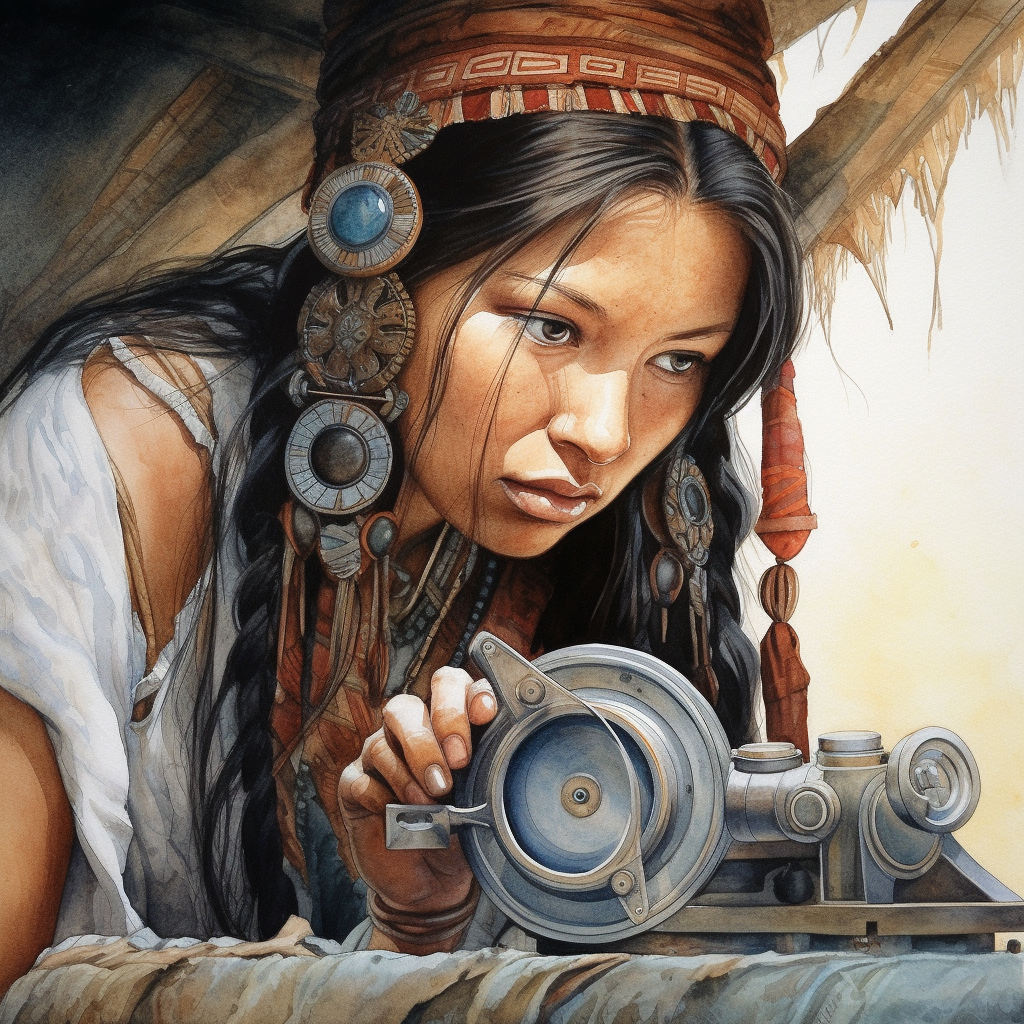Sahalie was a famous doctor, innovator, and political figure in Cascadia’s early history.
Among Sahalie’s most important accomplishments were the invention of the Tenasnah (ten-as-nah; literally “look small” in Chinook), also known as the microscope in English or portée minuscule in Australian French.

Sahalie’s Early Life
The daughter of a prominent family, as a young Chinook girl, she was especially precocious and gifted with languages. She served as a translator in trade negotiations for her nation, even at a young age, with other nations of the Wimahl river basin.
Sahalie and the Empire of Australia
Upon the arrival of the Espoir and the other trade ships of the Empire of Australia, Sahalie elected to join the crew of the Espoir on its trade mission back to the Empire. She became a personal aide to the ship’s captain, Helena d’Poitiers, a relative of the reigning Empress.
Sahalie, having learned French, English, and Norse on the journey to New Bordeaux, began attending the University of New Bordeaux at the urging of Helena D’Poitiers and under the direct patronage of Eleanor XV. Eleanor wrote in her diary that she considered the young girl to be a particular beauty and an incredibly gifted communicator, able to converse eloquently with the monarch on a variety of subjects.
Eleanor and Sahalie are thought to have had an intimate relationship, though no direct evidence of this exists, it was widely speculated at the time to have been the case.
Sahalie and Medicine
After graduating with honours from University, Sahalie was a sought after graduate from the various institutes of research that were sponsored by the Empress, including the Workshop of da Vinci and the Laboratoire du Corps. A sudden illness of a friend was said by Sahalie in her writings to have influenced her decision to study the new discipline of medicine and to engage with Alyce du Chessé as her mentor.
The two women worked on the problem of identifying disease and came up with the idea of using a recent invention for looking at far away objects as tool for examining spots of disease on the body as well. Sahalie’s invention was the Tenasnah, a microscope capable of looking closely at specimens of disease. They discovered that bacteria were responsible for many infections and began categorising these diseases.
In 1516, Sahalie, having perfected the portée minuscule, was awarded the title of Doctor of Advanced Medicine by the Laboratoire du Corps.
As word of an outbreak in her homeland of Cascadia reached her, Sahalie implored Eleanor XV to lift the isolation of her homeland so she could return to cure the outbreak. In her official letters, Eleanor is said to have been moved by the younger woman’s eloquence and granted the request. Sahalie was on the first ship to reconnect with Cascadia after the outbreak.
Variola Outbreak
One of the deadly viruses that the people of Cascadia were newly exposed to through their contact with the Empire of Australia was the Variola pathogen. In 1515, Empress Eleanor XV declared a cessation of contact between the Empire of Australia and the Cascadia region due to the outbreak of Variola amongst the local Cascadian population as a safety measure. The order preventing contact lasted three years, after which Sahalie was able to successfully petition for a return to Cascadia in an effort to eradicate the disease amongst her people.
Sahalie’s Laboratoire
With funding from Eleanor XV, in 1519, Sahalie formed an offshoot of the Laboratoire du Corps in Port Eleanora. She welcomed its first class of just five students.
In 1521, Sahalie and her students discover those with previous infections of Catpox are immune to Variola. This thesis is tested and proven in her Port Eleanora laboratory and lays the foundation for the future eradication of the disease.
In 1551, after successful lobbying by the leaders of Pørtland, Sahalie elects to move her laboratoire to a new location in the region’s fastest growing city. The so-called Doctin House became Cascadia’s premiere medical school for the next four centuries. The sprawling medical school was situated on a vast set of grounds set aside in the Tualatin Hills of Pørtland’s west side.
The Reluctant Politician
In 1564, in the aftermath of the unexpected death of Millicent Bullstrode, Sahalie is nominated to serve as Overborgmeister of Pørtland. She demures, but is convinced after winning the snap election in a landslide.
During her time as Overborgmeister, Sahalie took on the challenge of sanitation within the young city and working with acolytes of the Workshop of Da Vinci, created a network of fresh water systems within the city that delivered this important resource to neighborhoods throughout the central area.
Before her efforts, death by dysentery was a common problem in Pørtland. She is credited with saving thousands of lives in the young city.
Despite these successes, Sahalie wrote in her journals that she longed to return to the lab, and after serving the remainder of her term she declined to stand for reelection.
Death and Legacy
In 1574, Sahalie was exposed to a virulent sample of a disease of unknown origin and succumbed to death after quarantining herself in her office for four days. With her last words, she ordered the building she died in to be burnt to prevent the further spread of the disease. The ruins of her office still stand as a memorial on the grounds of the Doctin House.
In the aftermath of her death, a group of proteges of Sahalie took over administration of Doctin House through a governing body supported by the government of Cascadia and the city of Pørtland.
In Pørtland, there is a boulevard named for Sahalie that leads to a large statue of her. It was near this statue that Johannes Morgen built his modern edifice to medical research, Morgen Genentech.
In 1772, Doctin Abraham Dower created the Sahalie Prize to be given out each year for advances in the medical field. Recent awardees of the Sahalie Prize have included Johannes Morgen, Klara Lassater, Emanuelle Yarra, and, jointly, Jasper Taylor and Toshe Marinos.

